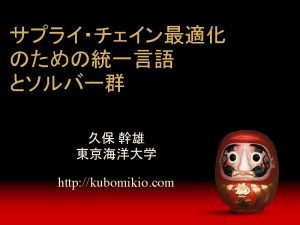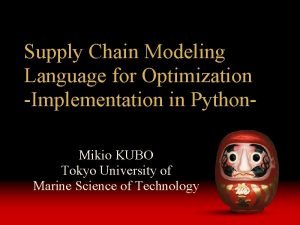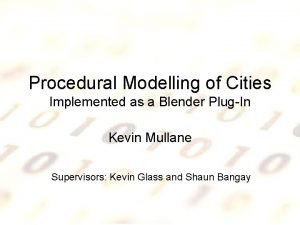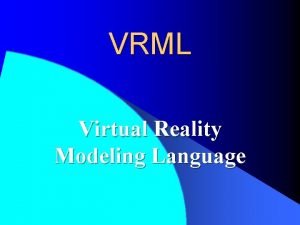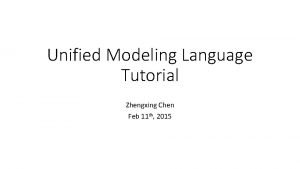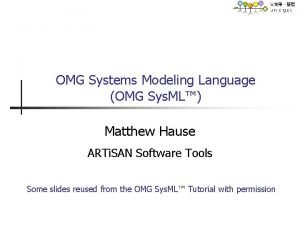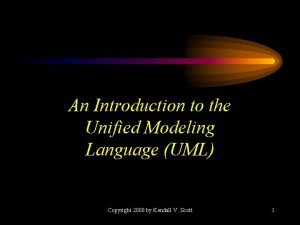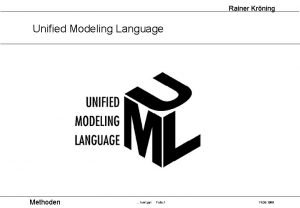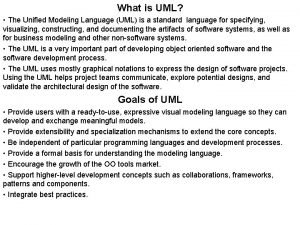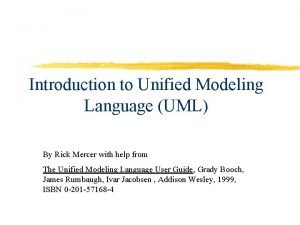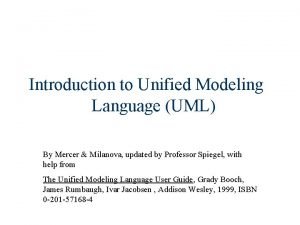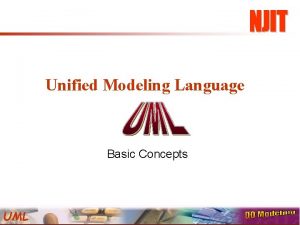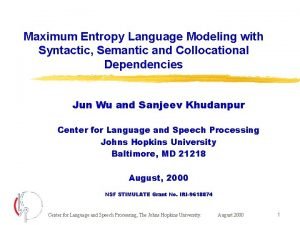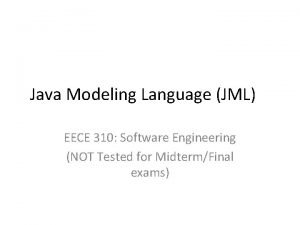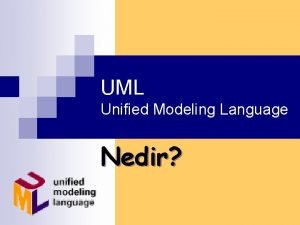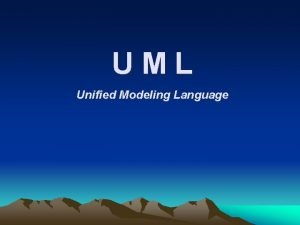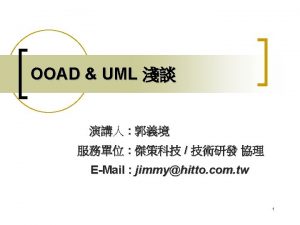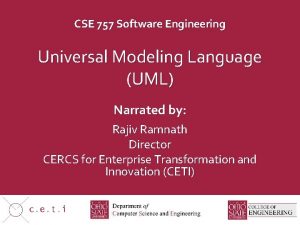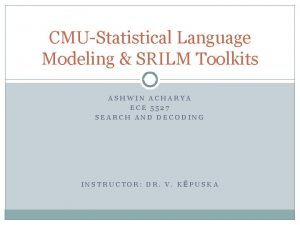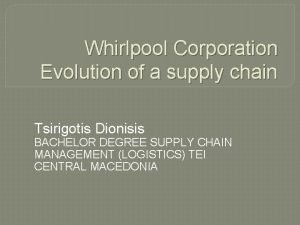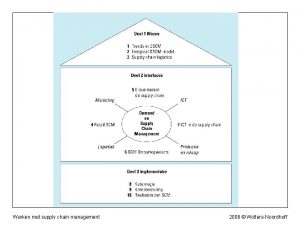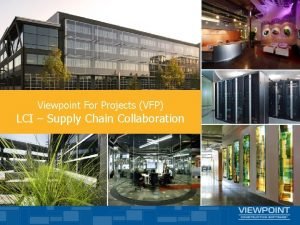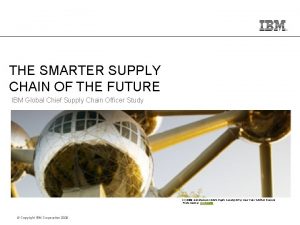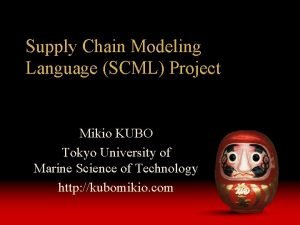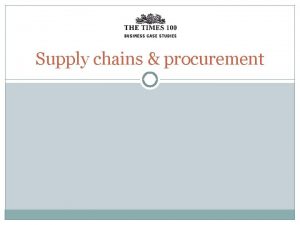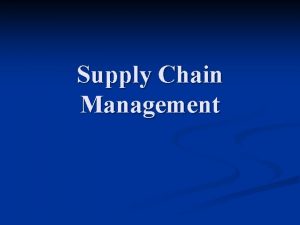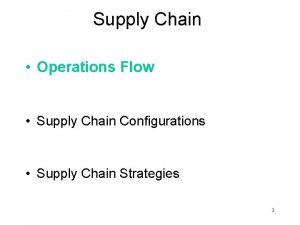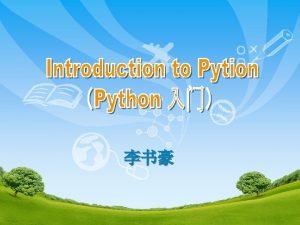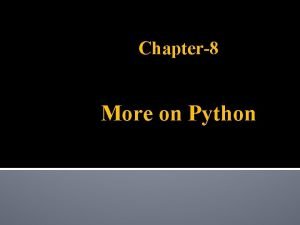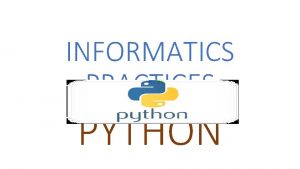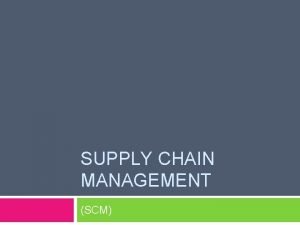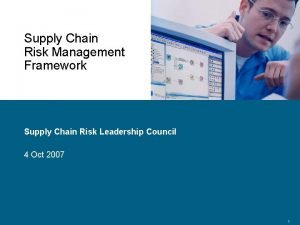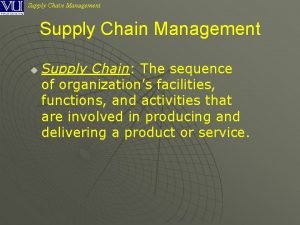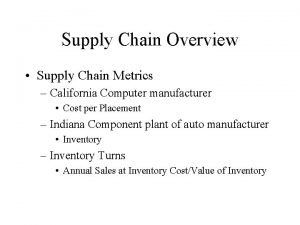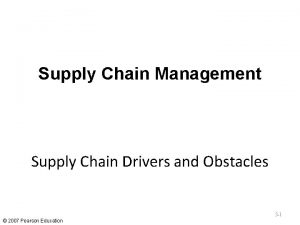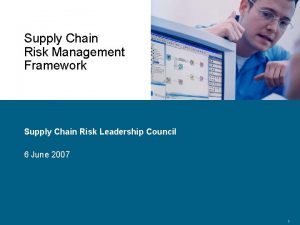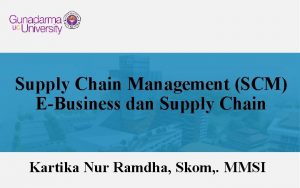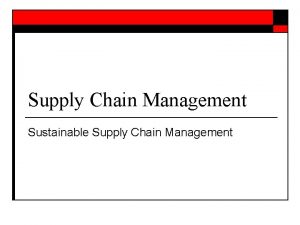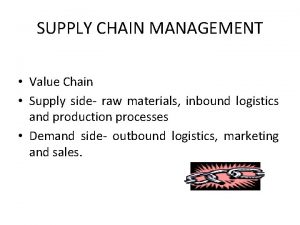SCML Supply Chain Modeling Language Python What is




































- Slides: 36


概要 • SCML (Supply Chain Modeling Language) とは • Pythonによる実装 • 応用

What is the SCML? Supply Chain Optimization Models proposed in 2009 by M. K. (international scheduling symposium) SCML Combinatorial Optimization Models Solvers (metaheuristics and/or MIP/CP)

What is the SCML. py ? Supply Chain Optimization Models SCML. py Solvers (metaheuristics and/or MIP/CP) Combinatorial Optimization Models サプライ・チェイン最適化の現在-統一言語 SCMLによるアプローチ-(朝倉書店; 2010出版予定)

Supply chain optimization models • • resource constrained scheduling (RCS) lot-sizing (LS) logistics network design (LND) safety stock allocation (SSA) economic order quantity (EOQ) inventory policy optimization (IPO) vehicle routing (VR)

Combinatorial optimization problems • • • set covering problem (SC) generalized assignment problem (GA) rectangular packing problem (RP) facility location problem (FL) etc. , . . .

Previous SCO models Flow models Scheduling models (LND, FL) (RCS, LS, VR) Constrained optimization models Multi-echelon inventory models (Algebraic modeling languages) (IPO, SSA, EOQ, LS)

Previous SCO models Network=(Node, Arc) Product, Resource Activity, Resource Flow models Scheduling models (LND, FL) (RCS, LS, VR) Constrained optimization models Multi-echelon inventory models (Algebraic modeling languages) (IPO, SSA, EOQ, LS) Variable, Constraint Product (BOM)

Entities of the SCML • • • activity resource product node arc Basic entities temporal piecewise horizon state solver etc. , . . .

Activity • Every action that requires the resources, consumes and/or produces the product, and derives the cost consume product Fixed Cost Variable Cost activity require resource product

Resource • Every entity of limited availability required and/or consumed by activities Our focus is on the physical, human, and financial resources.

Product • • Products are consumed and/or produced by activities Products are items or commodities through the network node product arc node product

Node and arc • Network is defined by the set of nodes and arcs node arc node

Declaration and attributes • • • activity resource product node arc activity declaration activity-name [attributes] attribute: duedate integer+ weight integer+ consume product-name unit real+. . . produce product-name unit real+. . .

Key concepts for implementing the SCML • Inheritance / Composition • Hierarchy • Global / Local

Inheritance

Entity class Entity has a name and attributes (defined by arguments as a dictionary) class Entity(): def __init__(self, name="", **args): self. name=name self. attributes=copy. deepcopy(args)

An activity object for LS act 1=Activity("act 1", variablecost=1, fixedcost=53, leadtime=3, resources={“mach 1": 1}, consume={"parts 1": 1, "parts 2": 2}, produce={"prod 1": 1}) parts 1 parts 2 consume Activity “act 1” prod 1 produce Resource “mach 1”

Composition

Hierarchy • Hierarchy can be defined on every entity using attribute “children” • Every attribute of a parent is copied to its children (same as inheritance) activity children Mode

Example: an activity object for RP item 1=Activity("item 1”, cost=10, children= “mode 1": {resources: {"width": 3, "height": 2}} , “mode 2”: {resources={"width": 2, "height": 3}, cost=5}) mode 1 (cost=10) mode 2 (cost=5)

Global / Local • Local products can be defined on nodes • Local activities and resources can be defined on arcs, i. e. , arcs can own activities and resources • Otherwise, entities are global. arc node consume product node produce activity require resource product

Example: a node object for LND source=Node("source", products= {"apple": {"holdingcost": 10, "supply": 100}, "melon": {"holdingcost": 10, "supply": 50}}) node "source" apple melon

Lot-sizing (LS) model horizon, activity, resource, product consume variablecost fixedcost activity produce resource product capacity demand holdingcost leadtime

Example for solving LS in python from SCML import * SCMLモジュールを読み込む sample=SCML() SCMLオブジェクトを生成 sample. set. Horizon(5) 計画期間を 5に設定 製品の情報入力 prod 1=Product("prod 1", demand=[5, 5, 6, 7, 8], holdingcost=5, leadtime=3) parts 1=Product("parts 1", holdingcost=1, leadtime=3) parts 2=Product("parts 2", holdingcost=1, leadtime=1) res 1=Resource(“res 1”, capacity={(0, “inf”): 25}) 資源の情報入力 活動の情報入力 act 1=Activity("act 1", variablecost=1, fixedcost=53, resources={"res 1": 1}, consume={"parts 1": 1, "parts 2": 2}, generate={"prod 1": 1}) sample. add. Activity(act 1) sample. add. Products(prod 1, parts 2) sample. add. Resource(res 1) sample. solve(“LS”) LSソルバーで求解

Resource constrained scheduling (RCS) model activity, resource, temporal, state min-max type temporal constraints with delay activity duedate, weight, parallel, break activity state time-dependent resource requirement children activities (=modes) resource time-dependent UB

Logistics network design (LND) model horizon, activity, resource, product, node, arc node product arc activities resources fixedcost consume node products variablecost cycletime activity produce product require resource holdingcost supply demand capacity Activity-based multi-period LND model

Vehicle routing (VR) model activity, resource, node, arc, piecewise time windows= duedate piecewise node depot arc time piecewise cost piecewise “move” activity a customer “vehicle” resource capacity location depot time piecewise

Inventory models horizon, product, activity, resource 1. (network type) economic ordering quantity model (EOQ) 2. safety stock allocation model (SSA) 3. inventory policy optimization model (IPO)

Inventory models and BOM fixedcost (EOQ) activity product demand, holdingcost (common) resource capacity (IPO) leadtime, basestocklevel, backordercost (IPO) servicetime, processingtime (SSA) cycletime (EOQ)


Generalized assignment (GA) aij (requirement) bi =>capacity cij (cost) jobs => activities agents =>resources activity resources: resource-name (aij, cij)

Rectangular packing (RP) height =>resource activity, resource, piecewise rectangle =>activity with children (modes) resource (width or height) capacity, piecewise width =>resource

Facility location (FL) problem • Multi-source Weber problem Given n nodes (customers) on a plane, find k locations of facilities • nodes: (attributes: x, y coordinates and weight) Example n=1000 k=30

Facility location (FL): Excel interface

Applications • Resource constrained scheduling: used in some large plants • Logistics network design: used as a consulting tool in three consulting firms • Vehicle routing: used as a core solver in some major companies • Hybrid models – Lot-sizing + Inventory policy optimization – Logistics network design + Resource constrained scheduling +Lot-sizing
 Supply chain optimization python
Supply chain optimization python Python supply chain optimization
Python supply chain optimization Matching supply and demand in supply chain
Matching supply and demand in supply chain Value chain and supply chain difference
Value chain and supply chain difference Sequence of food chain
Sequence of food chain Modeling role modeling theory
Modeling role modeling theory Relational vs dimensional data modeling
Relational vs dimensional data modeling Procedural modeling blender
Procedural modeling blender What is vrml
What is vrml Unified modeling language tutorial
Unified modeling language tutorial Omg systems modeling language
Omg systems modeling language Introduction to the unified modeling language
Introduction to the unified modeling language What does vrml stand for
What does vrml stand for Uml ppt
Uml ppt Pengertian unified modeling language
Pengertian unified modeling language What is uml
What is uml Universal modeling language
Universal modeling language Introduction to unified modeling language
Introduction to unified modeling language Mercer oneview login
Mercer oneview login Uniform modeling language
Uniform modeling language Language modeling incorporates rules of
Language modeling incorporates rules of Java modeling language
Java modeling language Uml diagram nasıl çizilir
Uml diagram nasıl çizilir Sebutkan fungsi dari
Sebutkan fungsi dari Object diagram captures the behavior of a single use case.
Object diagram captures the behavior of a single use case. Interaction overview diagram
Interaction overview diagram Omg unified modeling language
Omg unified modeling language Uml
Uml Srilm kndiscountn
Srilm kndiscountn Chapter 5 section 1 supply
Chapter 5 section 1 supply Ang elastisidad ng supply ay
Ang elastisidad ng supply ay Whirlpool corporation evolution of a supply chain
Whirlpool corporation evolution of a supply chain Werken met supply chain management noordhoff
Werken met supply chain management noordhoff Vfp viewpoint
Vfp viewpoint Enterprise resource planning ppt
Enterprise resource planning ppt Ibm smart supply chain
Ibm smart supply chain Pipeline in supply chain
Pipeline in supply chain
